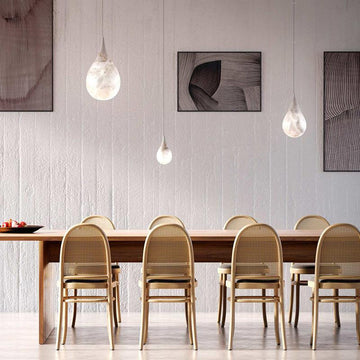Pendant lighting is a concept that strikes a balance between simplicity and complexity. In this exploration, we delve into the factors that characterize pendant lights, unraveling their unique features and shedding light on how to make the most of them. Additionally, we'll draw a clear distinction between pendant lights and hanging lights.

The Fusion of Form and Function
Effective pendant lighting seamlessly blends functionality with aesthetics, whether it's illuminating a home, a business office, a warehouse, or any other space. The brightness level of pendant lights plays a pivotal role in preserving the overall aesthetic of a room, making them an ideal choice, especially for kitchens.
If you're keen on unraveling the secrets of pendant lights and mastering their artful deployment, read on!
Styles of Pendant Lighting
At the heart of pendant lighting lies a simple yet captivating principle—a single bulb suspended in the air. However, to enhance visual appeal and reduce glare, most pendant lights feature a shade. Common materials used for pendant lights include glass, metal, plastic, and paper, each contributing to a distinct style and ambiance.
From sleek globes to intricate woven cages, the array of shapes is vast. And if you can't find the perfect shape, custom designs tailored to your preferences are often a possibility.
Whether your goal is practicality or aesthetics, pendant lights rise to the occasion!
Advantages of Pendant Lighting
-
Spotlighting Brilliance: Pendant lights excel as spotlights, drawing attention to specific areas. Skillful positioning can highlight key elements such as art, sculptures, or cherished items.
-
Versatility in Lighting: Pendant lights can project light both upwards and downwards, serving as either a primary or secondary light source. Their use as secondary lighting adds a distinctive touch to any room.
-
Space-Saving Elegance: Unlike floor lamps, pendant lights occupy no floor space. Strategically suspended from high ceilings, they provide ample lighting without impeding movement.
-
Mood Enhancement: Ideal for small businesses, pendant lights uplift the ambiance of office spaces, combating the dreariness of dimly lit environments.
Where to Showcase Pendant Lights
Pendant lights find their place in various settings, serving general, area, and task lighting purposes:
-
General Illumination: Placing a pendant light in the center of a room provides widespread illumination, making it perfect for living rooms, dining areas, or even porches.
-
Area Lighting: Illuminate specific zones, such as dining tables or cozy corners, with pendant lights tailored for area lighting.
-
Task Lighting: When focused illumination is needed, use pendant lights as spotlights over work desks or tables.
Whether suspended in the center of a room or gracefully illuminating a designated area, pendant lights effortlessly enhance any space.
Decoding the Distinction: Pendant vs. Hanging Lights

While pendant lights fall under the umbrella of hanging lights, not all hanging lights qualify as pendants.
-
Suspension Style: Pendant lights typically hang from the ceiling by a rope or chain, sometimes utilizing three for added flair.
-
Single-Bulb Simplicity: A defining feature of pendant lights is their reliance on a single bulb, distinguishing them from multi-bulb hanging lights.
Understanding these nuances allows you to navigate the diverse world of lighting options with confidence.

In conclusion, pendant lighting proves to be a versatile and sophisticated choice, enriching your home with both functionality and style. Now equipped with knowledge about pendant lights, embark on the journey of discovering the perfect pendant light for your home—because brilliance knows no bounds!













